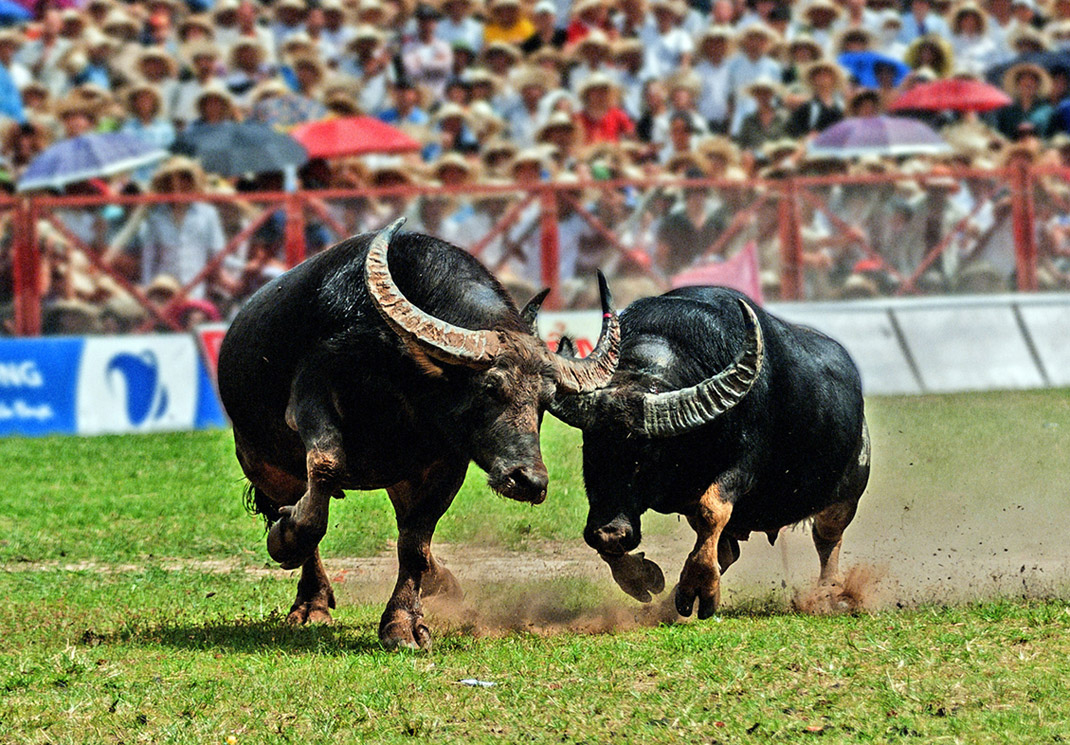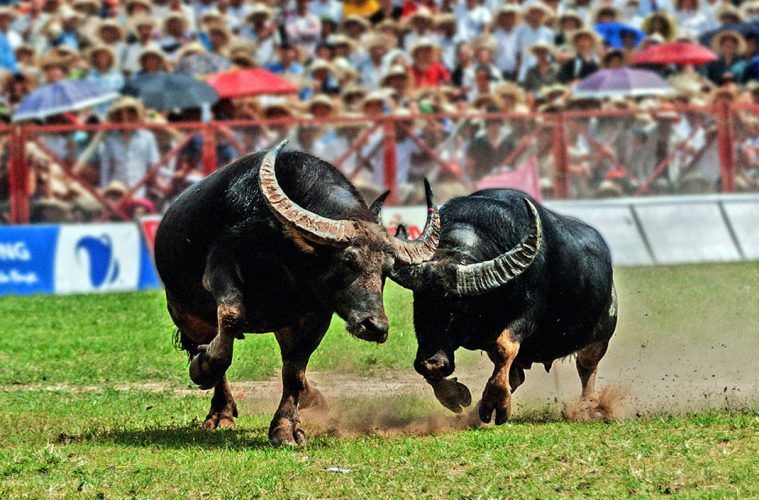BY NGOC ANH
(No.6, Vol.6,Aug-Sep 2016 Vietnam Heritage Magazine)

Photos: Nguyen Viet Rung
Once upon a time, fishermen of Do Son were being killed by sharks. They set up an altar to pray for help and promised to consecrate buffaloes to the gods if the gods would assist them. One night, there was a ferocious storm, and in the morning they saw dead sharks lying on the shore. The people thought that the sharks were killed by a divine bird. Since then, the fishermen have not been attacked by sharks. To keep their promise, they brought a pair of buffaloes to offer to their deities. Suddenly, during the ritual, the buffaloes broke loose and sprang into a heated fight. Thinking that the gods liked to watch them fight, the locals organized a buffalo fight every year to please and show gratitude to their guardian gods.
This is one of the many legends about the origins of the Buffalo Fight festival, which takes place on the 9th of the 8th lunar month every year at the Do Son district stadium of Hai Phong.
The Buffalo Fight festival has always been significant in the spiritual life of Do Son people. Since time immemorial they have passed around the following verses:
‘Wherever you are, whatever you trade.
Be back on the 9th of 8th when the horns lock.
Whatever you do, how ever busy you are,
Be back on the 9th of 8th when the horns swing.’
This is one of the 15 biggest festivals of Vietnam and a National Intangible Cultural Heritage.
The festival, especially the sacrificial part, shows respect for the sea gods and aspirations for peace and prosperity. Moreover, some culturologists even consider this festival a reflection of the martial spirit of the local communities and of the Vietnamese in general.
Months before the event, each village of the Do Son district sends an agent to find a fighter buffalo. The person must be savvy about every body part of a buffalo, including the head, face, forehead, ears, horns, jaws, hairs, neck, chest, cowlicks, ribcage, torso, legs, tail, stomach and genitalia to judge the animal’s potential.
Some experts in Hai Phong say that a good fighter buffalo must be over 4 years old, with broad chest, wide groin, slim neck, compact behind, curved horns and long thighs.
The villagers of Do Son show gratitude to their gods with fierce buffalo fights.

The fighter buffalo hunters may have to go far, even to the highlands to find one. Then follows a long period of arduous training and conditioning: running, uphill climbing, thick mud walking, adapting to harsh weather, awakening of the fighting instincts and spirit, and adapting to high levels of stress in a noisy and colourful crowd.
Early in the 6th lunar month (usually on the 8th day), the organizing committee lets the buffaloes enter the elimination rounds. The winners will take part in the official festival.
Early morning the 1st of the 8th lunar month, village elders and buffalo owners meet up to conduct the opening ritual at their Community temple. After that, each village brings their buffalo to their own village square for a consecration ritual to the Water and Village deities. After that, the animal becomes ‘His Horny’, the symbol of the village spirit, faith and aspirations.
Near the hour, ‘Their Hornies’ are respectfully conducted in trains with parasols and colourful flags to the arena under boisterous octet music. Sharply at 8 a.m. on the 9th day of the 8th lunar month, gong and drum beats announce the opening of the festival. Two buffalos enter the arena from the north and south gates. Another drum round, and the buffaloes move closer to each other. After another round, they are released and rush toward one another like avalanches and begin applying deadly moves such as ramming, banging, horn locking and overturning their opponent. The deadliest move is to kneel down on the front legs and swing the head, touching the ground to try and strike a horn into the opponent’s eye.
During each fight, the air bursts with people’s shouts and cheers and drum and gong and cymbal beats following the rhythmic and decisive movement of the controlling pennants.
Normally, 16 buffalo ‘gladiators’ take part in a festival. Each pair fights until a knock-out. Then they are separated and pulled back. The winning animal has the right to fight with other buffalos until the final round, if it is strong and lucky enough.
It is believed that a village that has a winning buffalo will have good fortune and its fishermen will be safe in their voyages and come back with good catches.
After the festival, all fighting buffaloes are butchered to be sacrificed to heaven and earth. It is believed that eating the meat of those buffaloes will also bring good luck.


